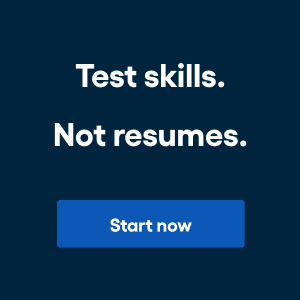The viral #10YearChallenge taking over our social media feeds inspired us: how has recruiting changed since 2009?
Flashback to 2009: the world of recruiting was a different place. The recession that began in 2008 was hitting the job market hard. The US unemployment rate hit 10.2%, the highest it had been in 10 years. HR teams were just learning how to use a little site called LinkedIn, which had been around since 2002, but didn’t have the widespread use it does today. In fact, some online experts declared 2009 “THE year to get to know and effectively utilize social media tools.” The terms “influencer” and “going viral” haven’t even registered in our collective consciousness.
A lot has changed since “learn how to use Twitter” was a hot recruiting tip. From retiring these outdated interview questions to the development of advanced HR tech, here are some of the ways recruiting has changed over the last 10 years.
2009: Interview candidates vs 2019: Perform a skills test
Job interviews have been around since the dawn of time (more like the 1920s, but you get what we mean). In 2009, candidates were answering the same tired questions at every job interview no matter what the company, industry, or position.
In 2019, things are looking up. More and more companies are rethinking the way they engage with candidates beyond the traditional interview. Each candidate experience is a chance to uncover more about a person beyond their resume. Skills tests and one-way video interviews provide a new level of customization. Instead of asking cookie-cutter questions, questions can be tailored to include everything from quick surveys to rigorous talent assessments, as well as testing particular skill sets that match the job description.
2009: Social media vs 2019: AI
Though it’s hard to picture, social media was still relatively new in 2009. Facebook allowed companies to open their own pages in May 2009. This was a time before employees started gratuitously wasting time on social media throughout the workday, and some experts recommended that companies encourage “employees to be more visible online,” and be active on Facebook, Friendster, MySpace, and Twitter.
Now, companies have evolved beyond asking their employees to create social media profiles. Recruitment marketing is a major focus for HR teams. Instead of asking employees to search around social media for potential new hires, companies are adding artificial intelligence to their arsenal. HR teams are getting smarter, more agile, and more efficient at identifying, vetting, and hiring the right people for their company.
2009: Hiring practices are “disturbingly vague” vs 2019: Recruitment branding and marketing
In 2009, the markets were down and there was simply no money to bring on new candidates. Salaries were frozen, promotions were pushed off, and new positions were cancelled in the wake of the financial meltdown. During this time, recruiting teams put little to no effort into attracting candidates, partly because there were no open positions and partly because there were so many people seeking jobs that recruiters had a wealth of talent to choose from. As Harvard Business Review put it then, “current hiring practices are haphazard at best and ineffective at worst.”
This year, a company with “haphazard” hiring practices will be punished for their inefficiency. The tables have turned: a company must compete over the candidate. Unemployment is at a low 3.9%, and as a result, recruiters are building talent pools and applying marketing practices to their hiring processes.
2009: Reliance on employee referrals vs 2019: Sourcing tools and recruitment management systems
Ten years ago, employee referrals were considered the holy grail of marketing. In one survey, more than 75% of HR teams reported investing in employee referrals to help find top candidates. While employee referrals are still one of the top priorities for recruiters, sourcing tools and recruitment management platforms are helping identify candidates from different backgrounds. HR tech platforms combined with AI and skills testing allow recruiting managers to bring diversity, innovation, and fresh ideas to the workforce.
2009: Hiring for “fit” vs 2019: Hiring for diversity and inclusivity
For more than a decade, companies have sought out new hires that fit with their existing culture. As Patty McCord, the former chief talent officer at Netflix, explains, hiring for “culture fit” can serve to reinforce the glass ceiling and other barriers that contribute to a lack of diversity in an organization. “What most people really mean when they say someone is a good fit culturally is that he or she is someone they’d like to have a beer with. But people with all sorts of personalities can be great at the job you need done.”
The hiring landscape looks quite different in 2019, and not just because of the #metoo movement. The rise of remote work and a globalized workforce makes it possible for companies to source talent from all over the world. Inclusivity and diversity are values that consumers now stand for, and they make their purchasing decisions with a new commitment to conscious capitalism.




















